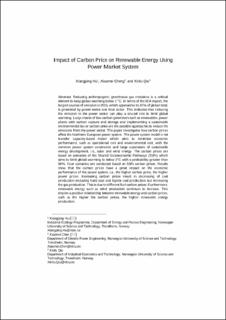| dc.description.abstract | Reducing anthropogenic greenhouse gas emissions is a critical element to keep global warming below 2 °C. In terms of the IEA report, the largest sources of emission in 2016, which approaches to 42% of global total, is generated by power sector and heat sector. This indicates that reducing the emission in the power sector can play a crucial role to limit global warming. Large shares of low-carbon generators such as renewables, power plants with carbon capture and storage and implementing a sustainable environmental tax or carbon price are the possible approaches to reduce the emissions from the power sector. The paper investigates how carbon prices affect the Northern European power system. The power system model is net transfer capacity-based model which aims to minimize economic performance, such as operational cost and environmental cost, with the common power system constraints and large expansions of sustainable energy development, i.e., solar and wind energy. The carbon prices are based on scenarios of the Shared Socioeconomic Pathways (SSPs) which aims to limit global warming to below 2 °C with a probability greater than 66%. Four scenarios are conducted based on SSPs carbon prices. Results show that the carbon prices have a great impact on the economic performance of the power system, i.e., the higher carbon price, the higher power prices. Increasing carbon prices result in decreasing of coal production including hard coal and lignite coal production but increasing the gas production. This is due to different fuel carbon prices. Furthermore, renewable energy such as wind production continues to increase. This implies a positive relationship between renewable energy and carbon prices, such as the higher the carbon prices, the higher renewable energy production. | en_US |
